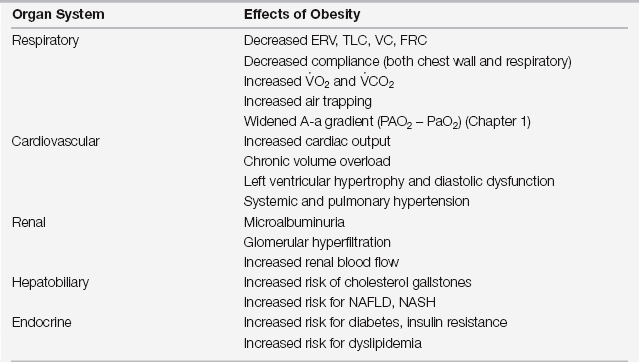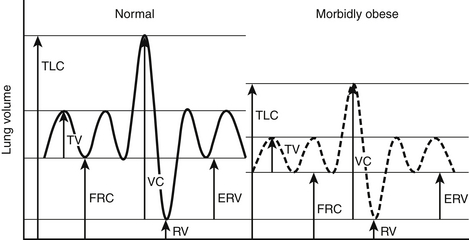Chapter 29
Care of the Patient with Morbid Obesity
Background/Epidemiology
Worldwide at least 1 billion people are overweight, and more than 300 million are obese. The United States is experiencing an epidemic of obesity. The national health surveys conducted in 2009-2010 estimated more than one third of the adult U.S. population (about 78 million) as obese and virtually guarantee the presence of obese patients in the intensive care unit (ICU). The critically ill obese patient presents unique challenges that must be understood and anticipated to ensure optimal delivery of care (Table 29.1).
Respiratory Effects of Obesity
1. The severity of the obesity (morbid obesity has a near-universal impact)
2. The distribution of the body fat (central, abdominal adiposity adversely affects pulmonary mechanics more than other distributions)
The most commonly encountered pulmonary function change is a decrease in the expiratory reserve volume (ERV), ascribed to the cephalad displacement of the diaphragm by adipose tissue (Figure 29.1). Other frequent changes include increases in the ratio of the forced expiratory volume in one second (FEV1) to the forced vital capacity (FVC; ratio: FEV1/FVC). As obesity becomes extreme, lung volumes can become more deranged with low total lung capacity (TLC), vital capacity (VC), and functional residual capacity (FRC). As expected, the respiratory system compliance is decreased, from the mechanical effects of the adipose tissue on the thoracic cage (chest wall restriction), and also on lung compliance from the reduced FRC with dependent atelectasis. Interestingly, residual volume (RV) may be increased relative to TLC (i.e., RV/TLC ratio), reflecting a reduction in small airway caliber and susceptibility to premature airway closure, precipitating gas trapping. Furthermore, evidence implicates increased rates of asthma in the obese population.
The respiratory system derangements produced by obesity are exacerbated by the supine position of a critically ill patient. The maximal displacement of the diaphragm and added weight of the chest cause peripheral airway closure in dependent lung regions (atelectasis), resulting in mismatch of ventilation and perfusion. This ventilation/perfusion ( ) mismatch creates a widened alveolar to arterial oxygen gradient (PAo2-Pao2), along with typically mild to moderate hypoxemia. Severe hypoxemia may be present, however, in individuals with the obesity hypoventilation syndrome (as a result of the additional contribution of hypoventilation; see Chapter 80) or in the postoperative patient (especially following thoracic and upper abdominal surgeries; see Chapter 90). Even severe hypoxemia may present with a relatively unremarkable chest radiograph, or perhaps minimal basilar atelectasis.
) mismatch creates a widened alveolar to arterial oxygen gradient (PAo2-Pao2), along with typically mild to moderate hypoxemia. Severe hypoxemia may be present, however, in individuals with the obesity hypoventilation syndrome (as a result of the additional contribution of hypoventilation; see Chapter 80) or in the postoperative patient (especially following thoracic and upper abdominal surgeries; see Chapter 90). Even severe hypoxemia may present with a relatively unremarkable chest radiograph, or perhaps minimal basilar atelectasis.
An elevated work of breathing predisposes obese patients with critical illness to respiratory failure. At baseline, obese patients have a high oxygen consumption ( O2), although oxygen consumption per kilogram is somewhat reduced given the relatively low metabolic rate of adipose tissue. Furthermore, the fraction of oxygen consumption related to the work of breathing is very high, from highly inefficient respiratory muscle function. Therefore, morbidly obese patients should be viewed as manifesting chronic ventilatory failure in which relatively small additional increases in
O2), although oxygen consumption per kilogram is somewhat reduced given the relatively low metabolic rate of adipose tissue. Furthermore, the fraction of oxygen consumption related to the work of breathing is very high, from highly inefficient respiratory muscle function. Therefore, morbidly obese patients should be viewed as manifesting chronic ventilatory failure in which relatively small additional increases in  O2 or carbon dioxide production (
O2 or carbon dioxide production ( CO2) (i.e., from sepsis or respiratory compensation for metabolic acidosis) precipitate acute hypercapnic respiratory failure (Chapter 1).
CO2) (i.e., from sepsis or respiratory compensation for metabolic acidosis) precipitate acute hypercapnic respiratory failure (Chapter 1).
Cardiovascular Effects of Obesity
Pulmonary hypertension with right ventricular hypertrophy and dilation may accompany obesity. When not caused by left ventricular failure, pulmonary hypertension in obese patients typically arises from sustained hypercapnia and hypoxemia (because of obesity hypoventilation [Chapter 80] or concomitant chronic obstructive pulmonary disease), eliciting pulmonary vasoconstriction. Absent effective therapy (weight loss, nocturnal invasive or non-invasive ventilation, supplemental oxygen), such pulmonary hypertension can produce cor pulmonale.
Other Organ System Manifestations
The hepatobiliary system endures damages as well. Obesity is a well-established risk factor for cholesterol gallstones, increasing the likelihood of biliary sepsis and gallstone pancreatitis. Multiple studies reveal obese subjects have ultrasonographic evidence of fatty liver, and 30% of these patients have documented nonalcoholic steatohepatitis (NASH) that may progress to cirrhosis. The degree of obesity parallels the likelihood for both fatty liver and NASH.
Implications for Management
Airway
Endotracheal intubation in obese critically ill patients can be difficult because of limited neck mobility, reduced mouth opening, and short sternomental distance. Not BMI alone, but large neck circumference and a Mallampati score of 3 or more (Chapter 80) are significantly correlated with a high probability of problematic intubation. Further, the supine position for intubation may precipitate significant airway closure and potential arterial oxyhemoglobin desaturation, a situation minimally responsive to bag-mask ventilation. Reasonable approaches include the ramped position coupled with awake intubation when laryngeal structures cannot be visualized, and rapid sequence intubation for the remaining obese patients. The high risk of aspiration in this population during intubation emphasizes the importance of cricoid pressure and other measures during intubation (Chapter 30).
In the event of a need for tracheostomy, an experienced surgeon is necessary. There remains debate regarding the safety of percutaneous dilatational tracheostomy, the need for custom-fit tracheostomy tubes, and tracheotomy techniques that remove cervical fat (Chapters 22 and 30). Beyond the usual indications, tracheostomy should be anticipated early in the patient with severe obesity hypoventilation syndrome with baseline daytime hypercapnia and hypoxemia (Chapter 80).

Full access? Get Clinical Tree



 2, oxygen consumption;
2, oxygen consumption;  CO2, carbon dioxide production; NAFLD, nonalcoholic fatty liver disease; NASH, nonalcoholic steatohepatitis.
CO2, carbon dioxide production; NAFLD, nonalcoholic fatty liver disease; NASH, nonalcoholic steatohepatitis.

